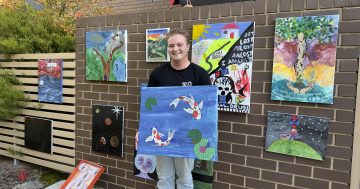I went down at lunch to see the Youth Homelessness Matters Day event at Garema Place for myself. It was like all of the usual Garema Place events- bands that do Blink 182 and Greenday covers; a coffee van; some BBQ sausages; as well as stalls from organisations relevant to this issue.
Once there, I had a chat to the head of the Youth Coalition of the ACT, Emma Robertson, to learn a little more about the event, and youth homelessness in general.
She told me that the main purpose of the event was to raise awareness within the general public. As the ACT is more affluent than other states, youth homelessness tends to be an issue that most don’t realise exists. When they do realise that it exists, people assume that the only solution is to open up some shelters. Youth homelessness goes a lot deeper than that. Simply putting a stable roof over their heads does not help to tackles the issues that led to homelessness; such as family disputes, disengagement from education, a lack of income, as well as many other individual issues that can lead to homelessness.
Emma also spoke to me about how the three classifications the Youth Coalition applies to homelessness: primary, secondary and tertiary. Primary refers to youths that are sleeping on the streets and in bus stops. Secondary refers to youths that don’t have a stable home, and tend to be moving every few days. Tertiary is when youths have a roof over their head, but they are dealing with issues such as overcrowded accommodation, no running water, or violence, to name a few. As Emma says “homelessness is not rooflessness.”
The main category of youth homelessness in the ACT is secondary, which means that it is often out of the public eye. One of the aims of the Youth Coalition is make people aware of it, and aware that we all need to be part of the solution. For example, private renters could consider renting out to younger people, employers could begin hiring more young people, and we could start to hold government accountable.
The image of Rubik’s Cube, the symbol of YHMD, is fittingly used to represent that all pieces need to work together to solve the puzzle.
Did anyone else go to the YHMD event today? If yes, what did you think of it?














